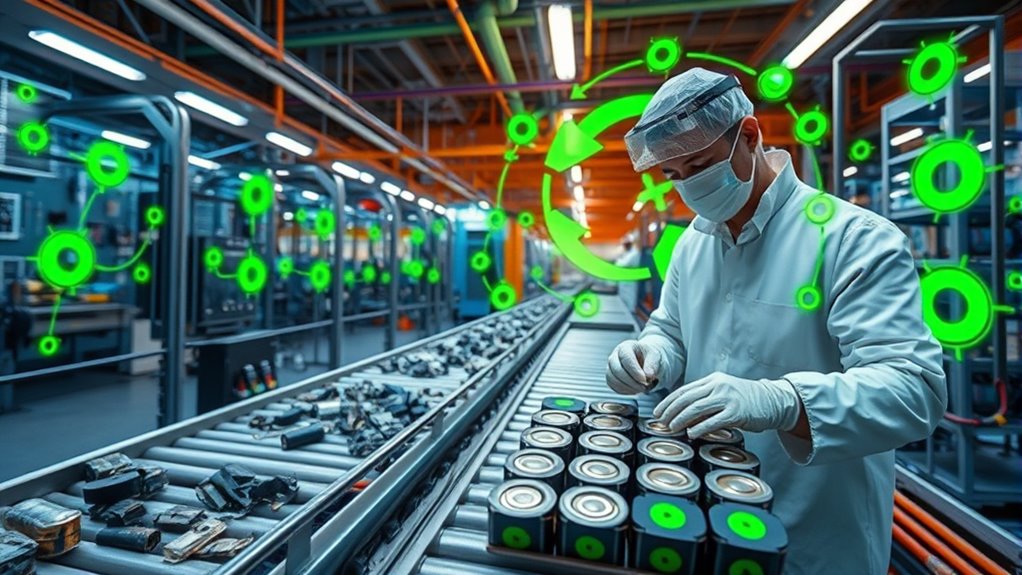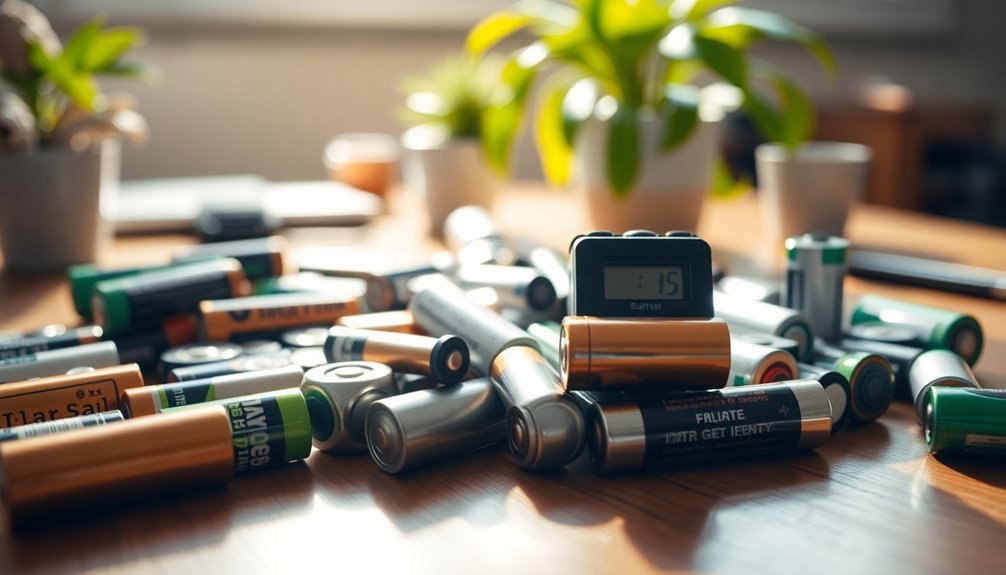In a circular economy for batteries, you focus on designing products for easy recycling and reuse, recovering valuable materials like lithium and cobalt to reduce raw material extraction. Reusing second-life batteries and collaborating across industries help extend battery lifespan while minimizing waste. Proper disposal at designated facilities guarantees environmental safety. By supporting sustainable practices, you contribute to resource conservation and a healthier planet. To discover more about effective principles and practices, keep exploring how these strategies work in real-world applications.
Key Takeaways
- Emphasizes recycling critical metals like lithium, cobalt, and nickel to recover resources and reduce raw material extraction.
- Promotes reuse and second-life applications of batteries, extending their lifespan and delaying disposal.
- Encourages designing batteries for easier disassembly and recycling to improve efficiency and reduce waste.
- Fosters collaboration among manufacturers, consumers, and recyclers to ensure proper collection and processing.
- Supports industry best practices that minimize environmental impact and create a closed-loop system for battery materials.

The circular economy in batteries offers a sustainable solution to the growing demand for energy storage while reducing environmental impact. As you look for ways to minimize waste and maximize resource efficiency, understanding how battery recycling and material reuse fit into this model becomes essential. Instead of treating batteries as disposable items, you can see them as valuable resources that can be reprocessed and reintegrated into manufacturing cycles. This approach not only reduces the need for raw material extraction but also curtails the environmental footprint associated with mining and processing new materials. When you participate in battery recycling, you help recover critical metals like lithium, cobalt, and nickel, which can then be reused in the production of new batteries. This process closes the loop, ensuring that valuable materials don’t end up in landfills but instead continue to circulate within the economy.
Embracing battery recycling and reuse reduces waste, conserves resources, and supports a sustainable, circular economy in energy storage.
Material reuse plays a pivotal role in the circular economy by extending the life cycle of battery components. Instead of scrapping a battery once it reaches end-of-life, you can refurbish or repurpose its parts, particularly the electrodes and casing, for alternative uses or second-life applications. For example, used electric vehicle batteries can serve as energy storage solutions for grid stabilization or backup power, giving them a second purpose and delaying disposal. This practice not only conserves resources but also offers economic benefits by reducing manufacturing costs and dependency on new raw materials. You can also support innovations in recycling technologies that make material recovery more efficient, ensuring higher purity levels and less waste during the process. Incorporating high-efficiency recycling methods is crucial for maximizing resource recovery and minimizing environmental impact.
Adopting best practices in the circular economy involves collaboration across industries, from manufacturers to consumers. You can contribute by properly recycling batteries at designated facilities, ensuring they are processed correctly and efficiently. Ensuring that the batteries are collected and sent to specialized recycling centers prevents hazardous materials from leaking into the environment. Manufacturers, on their part, can design batteries with disassembly and recycling in mind, facilitating easier material recovery and reuse. By choosing products that prioritize sustainability and recyclability, you promote a market shift towards more responsible manufacturing practices.
Ultimately, embracing the principles of the circular economy in batteries means actively participating in reducing waste, conserving resources, and fostering innovation. Your role as a consumer, recycler, or industry stakeholder directly influences the effectiveness of these efforts. By prioritizing battery recycling and material reuse, you’re helping create a more sustainable energy future—one where batteries are viewed not as one-time-use commodities but as integral components of a closed-loop system that benefits both the environment and the economy.
Frequently Asked Questions
How Do Circular Economy Principles Impact Battery Innovation?
Circular economy principles boost your battery innovation by encouraging sustainable battery design and material innovation. You focus on creating batteries that are easier to recycle, reuse, and repurpose, reducing waste. This approach drives you to develop new materials and design strategies that extend battery life and improve efficiency. As a result, you contribute to a more sustainable industry while meeting market demands for eco-friendly, high-performance batteries.
What Are the Economic Benefits of Implementing a Circular Battery Model?
Implementing a circular battery model offers you significant economic benefits, including cost reduction through efficient resource use. You’ll minimize material expenses by recycling and reusing batteries, which reduces reliance on raw materials. Enhanced resource efficiency means longer-lasting batteries and less waste, saving money over time. These practices can also create new revenue streams from recycled materials, boosting your overall profitability while supporting sustainable growth.
How Do Regulations Influence Battery Recycling and Reuse Initiatives?
Regulations shape your battery recycling and reuse efforts by enforcing strict standards, encouraging innovation, and ensuring safety. They require you to meet regulatory compliance, which drives you to adopt best practices. Policy incentives motivate you through subsidies, tax benefits, or grants, making reuse initiatives more financially viable. Together, these regulations and incentives guide your actions, helping you develop sustainable, efficient, and compliant battery management systems that align with environmental and economic goals.
What Challenges Exist in Scaling Circular Battery Practices Globally?
You face challenges in scaling circular battery practices globally due to supply chain complexities and the lack of technological standardization. These issues make it difficult to create seamless recycling processes and consistent reuse methods across different regions. Overcoming these hurdles requires international cooperation, developing universal standards, and improving logistics. By addressing these challenges, you can accelerate the adoption of circular practices and reduce environmental impacts worldwide.
How Can Consumers Participate in Promoting a Circular Economy for Batteries?
You can promote a circular economy for batteries by staying informed about consumer awareness and supporting recycling programs. Don’t assume recycling is complicated; many programs make it easy—just drop off your used batteries at designated centers. By actively participating, you help reduce waste and encourage manufacturers to adopt sustainable practices. Your involvement creates a ripple effect, inspiring others to join the effort and keep valuable materials in use.
Conclusion
Embracing the circular economy in batteries is like planting a seed for a sustainable future. Each reused component, recycled cell, and mindful disposal acts as water and sunlight, nurturing growth. By choosing this path, you become the gardener tending to a thriving ecosystem, where resources flourish and waste diminishes. Your actions are the seed that blooms into innovation and responsibility—transforming a cycle of consumption into a perpetual cycle of renewal.









